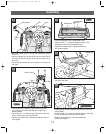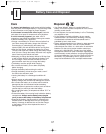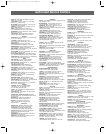
Rules for Safe Driving
J
y
Teach Safety Rules to Children
While children can quickly develop the skill necessary to
drive this vehicle, it is important to remember that their
judgment skills are still very immature. Unsupervised dri-
ving by children can lead to serious injury. Before children
use this vehicle, an adult should carefully evaluate the
driving area as well as the children’s skill level and ability
to drive this vehicle safely. Children are not always able to
recognize or anticipate hazards, even when they have
been taught about them. There is no acceptable substi-
tute for direct adult supervision.
Teach appropriate safety rules to your child before allowing
operation of this vehicle. These rules should also be
reviewed with neighborhood children or other playmates
who want to drive this vehicle.
Riding Rules
Make sure children know and follow these rules for
safe driving:
1. Always sit on the seat.
2. Always wear shoes.
3. Only 1 (one) rider at a time. A child who is not sitting on
the seat or who is standing on the vehicle could fall off,
cause a tip-over or block the driver’s view. A child could
be seriously injured.
4. Do not allow any child to drive the vehicle in the street
or near moving (motorized) vehicles.
5. Do not allow any child to drive near bodies of water
(such as pools or creeks), obstructions (such as furni-
ture, low tree limbs or play equipment), or drop-offs
(such as stairs or decks).
6. Do not allow any child to drive the vehicle in the dark.
A child could encounter unexpected obstacles and have
an accident. Operate the vehicle only in the daytime or
a well-lit area.
7. Do not allow your child to drive on sloped or inclined
surfaces. Restrict your child’s driving to generally
level ground ONLY!
8. Do not allow your child to drive down or across a
steep slope.
- The vehicle may gain unsafe speed, even if the
pedal is released to stop.
- The vehicle may tilt and tip over.
- The wheels could lose traction, causing the vehicle
to slip.
9. Do not allow your child to drive up steep inclines. The
motor may stop and the vehicle could roll backwards at
an unsafe speed.
10. Never put anything near any moving parts. Rotating
parts such as motors, gear boxes and wheels can snag
fingers, hair, etc., causing serious injury. Do not allow
operation of the vehicle when it is on its side or in an
upside-down position.
11. Do not operate the vehicle near flammable vapors
(gasoline, paint thinner, acetone, liquid wax, etc.).
The vehicle’s electrical switches, like most electrical
switches, emit an internal spark when first turned on or
turned off. The presence of flammable liquids or vapors
could cause an explosion or a fire. Keep all flammable
products in tightly sealed containers and away from
the vehicle.
12. Do not allow a child to operate the vehicle without
direct adult supervision. To prevent unsupervised use
of the vehicle, disconnect the motor harness from the
battery when the vehicle is not in use.
To disconnect the motor harness connector an
battery connector:
– Lift the hood.
– Remove the battery clamp (engine cover).
– Squeeze the tabs on the motor harness connector to
unplug it from the battery connector.
– Replace the battery clamp (engine cover).
– Lower the hood and fasten the hood latches.
WARNING
Prevent Injuries and Deaths
• Direct Adult Supervision Required
• Keep Children Within Safe Riding Areas
These areas must be:
- away from swimming pools and other
bodies of water to prevent drownings
- generally level to prevent tipovers
- away from steps, driveways, roads
and alleys.
Use vehicle on generally level ground ONLY!
RIDING HAZARD
18
74388pr-0921.qrk 7/13/01 1:38 PM Page 18


















